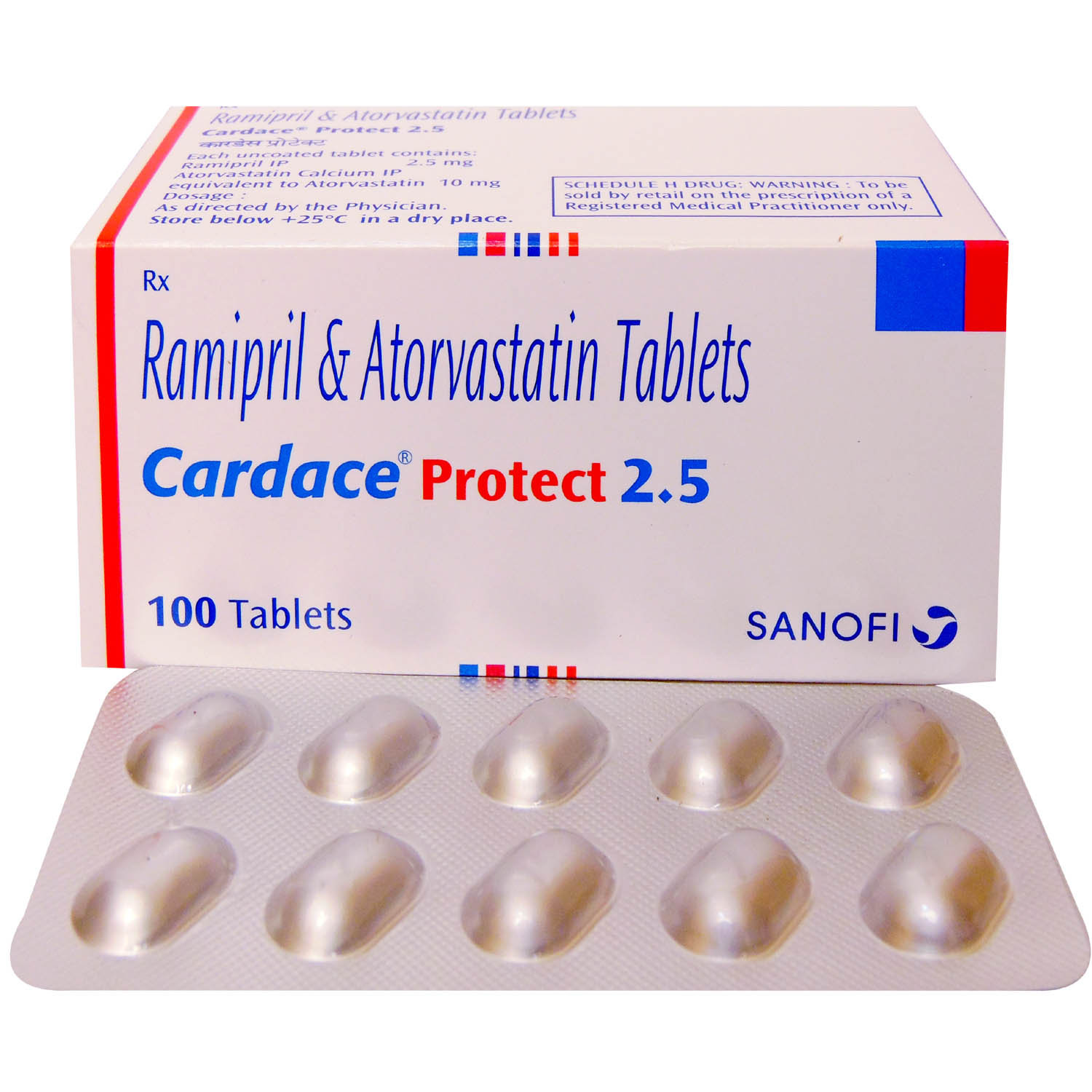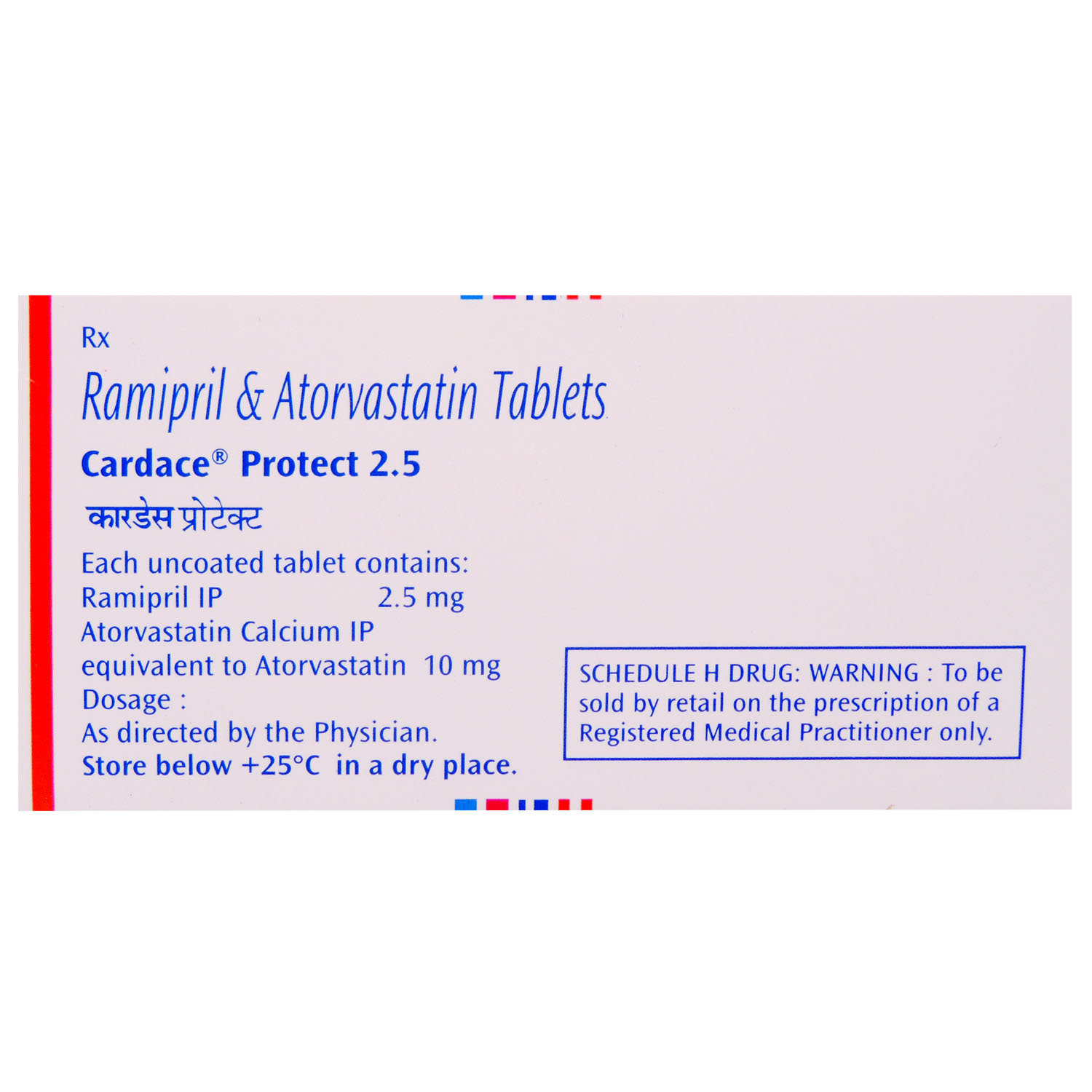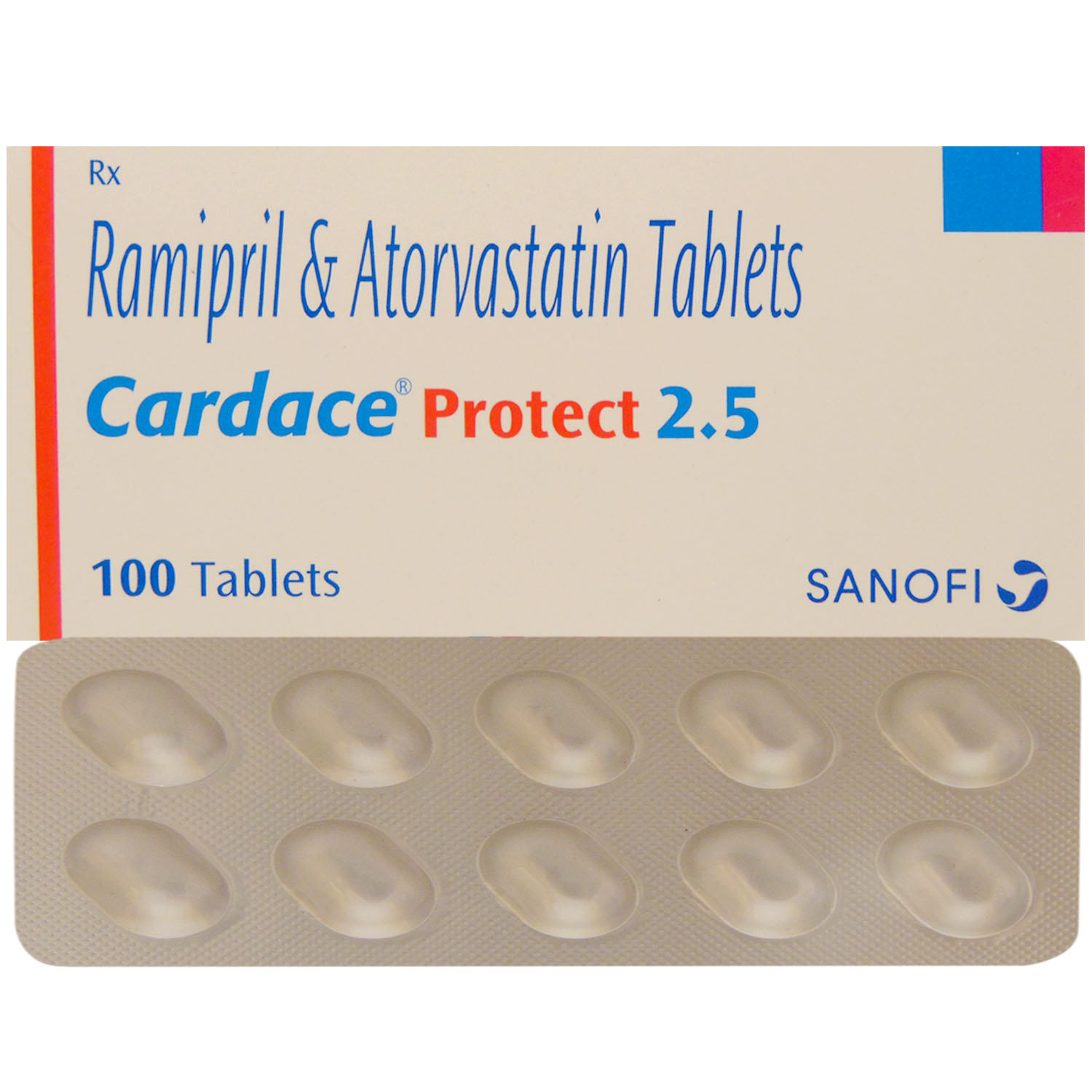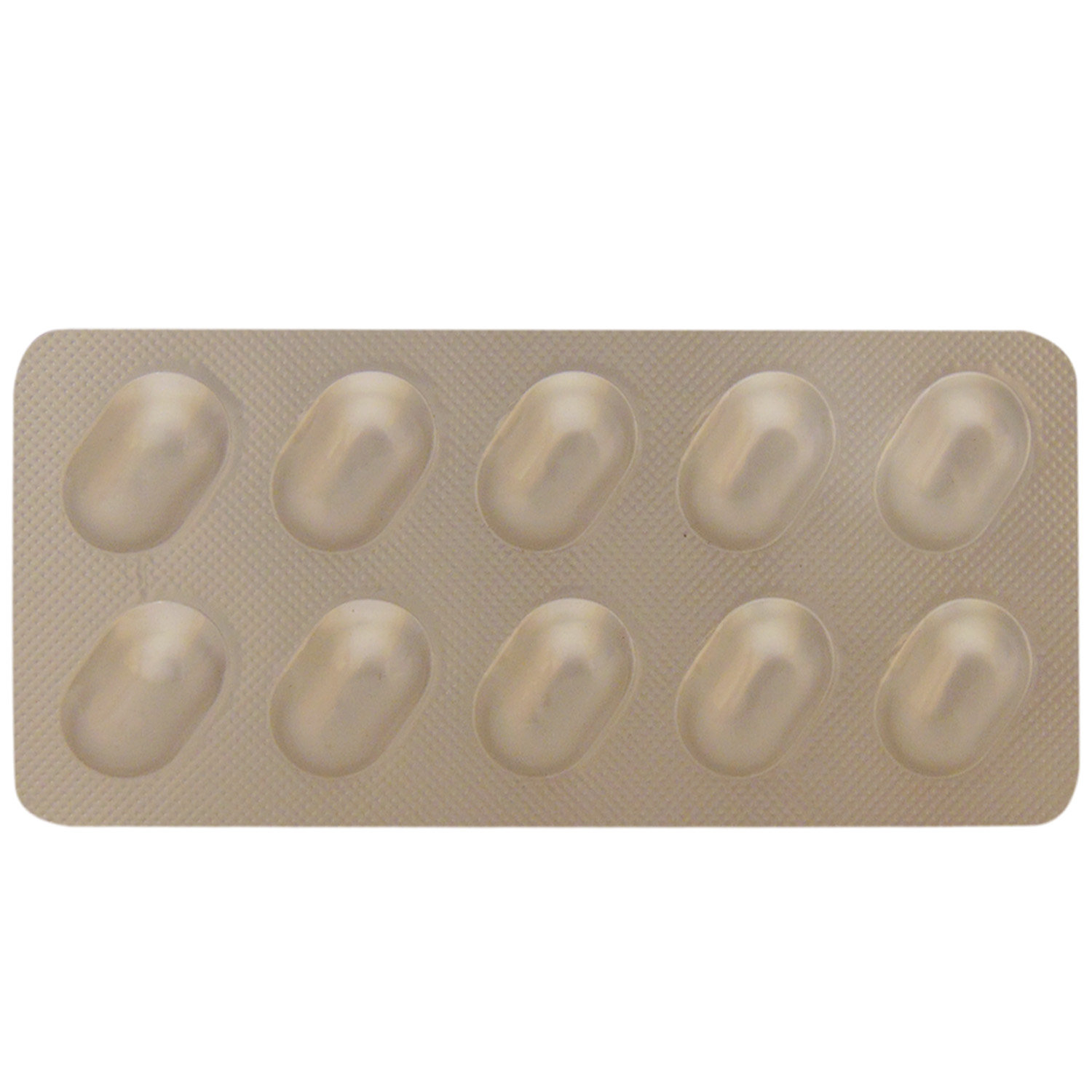Cardace Protect 2.5 Tablet






MRP ₹201
(Inclusive of all Taxes)
₹30.1 Cashback (15%)
know your delivery time
Provide Delivery Location
Composition :
Manufacturer/Marketer :
Consume Type :
Expires on or after :
Return Policy :

Secure Payment

Trusted by 8 Crore Indians

Genuine Products
Therapeutic Class
Country of origin
Manufacturer/Marketer address
Disclaimer
Alcohol
Safe if prescribed
Cardace Protect 2.5 Tablet should not be taken until prescribed if you are taking alcohol. Keep your doctor informed if you drink alcohol. Drinking alcohol with Cardace Protect 2.5 Tablet may potentiate gastric or stomach bleeding and ulcer symptoms. So, try to avoid or limit the consumption of alcoholic beverages while using Cardace Protect 2.5 Tablet .
Pregnancy
Consult your doctor
Cardace Protect 2.5 Tablet is not recommended for use in pregnancy. If you are pregnant, consult your doctor before taking this medicine.
Breast Feeding
Consult your doctor
If you are breastfeeding, consult your doctor before taking this medicine. Your doctor will weigh the benefits and risks before prescribing it.
Driving
Safe if prescribed
Drive with caution as Cardace Protect 2.5 Tablet can cause dizziness and may affect your driving ability.
Liver
Consult your doctor
Cardace Protect 2.5 Tablet to be taken with caution, especially if you have a history of liver diseases/conditions. Your doctor may adjust the dose based on your condition.
Kidney
Consult your doctor
Cardace Protect 2.5 Tablet to be taken with caution, especially if you have a history of kidney diseases/conditions. Your doctor may adjust the dose based on your condition.
Children
Safe if prescribed
Cardace Protect 2.5 Tablet is not recommended for children below the age of 12 years. The safety and effectiveness of Cardace Protect 2.5 Tablet have not been established in children.
About Cardace Protect 2.5 Tablet
Cardace Protect 2.5 Tablet is an anti-hypertensive medicine primarily used to treat high blood pressure (hypertension) and reduce the risk of having a heart attack, stroke, or heart failure. Besides this, it also lowers the raised level of bad cholesterol (especially for those at high risk of heart disease). High blood pressure is a chronic condition in which the pressure in the blood vessels is high. The blood exerts high pressure on the walls of blood vessels (arteries), leading to hypertension. Heart failure can occur when your heart cannot pump the blood sufficiently required to the remaining body. A heart attack is the blockage of blood flow to the heart muscle. The blockage is most often a build-up of fat, cholesterol, and other substances, forming plaque in the arteries that feed the heart (coronary arteries). Heart attack and brain stroke happen simultaneously, as, in a stroke, the blood supply to the brain gets interrupted, causing a part of the brain to die.
Cardace Protect 2.5 Tablet is made up of two medications: atorvastatin and ramipril. Atorvastatin is a cholesterol-lowering medication that inhibits the enzyme responsible for fat production in the body. It lowers bad cholesterol (also known as LDL or low-density lipoproteins) and triglycerides (TG). It raises good cholesterol levels (also known as high-density lipoproteins or HDL). Ramipril is an angiotensin-converting enzyme (ACE) inhibitor that lowers high blood pressure by blocking angiotensin II, a naturally occurring substance that tightens your blood vessels. This relaxes blood vessels in the body, reducing the burden on the heart to pump more blood. Cardace Protect 2.5 Tablet reduces the risk of heart attack, stroke, and heart-related chest pain when taken together (angina).
You are advised to take Cardace Protect 2.5 Tablet for as long as your doctor has prescribed it for you, depending upon your medical condition. The most common side effects of Cardace Protect 2.5 Tablet are increased bleeding tendency, constipation, headache, muscle pain, weakness, headaches, decreased blood pressure, dizziness, muscle pain, increased blood glucose level, and cough in some cases. Most of these side effects of Cardace Protect 2.5 Tablet do not require medical attention and gradually resolve over time. However, if the side effects are persistent, reach out to your doctor.
Try not to stop taking this medicine of your own. Stopping Cardace Protect 2.5 Tablet abruptly may worsen your condition and increase your risk of a future heart attack. Tell your doctor if you are sensitive to atorvastatin or have any active liver disease, active bleeding issues (like a peptic ulcer or brain haemorrhage), muscle problems (myopathy, rhabdomyolysis), pregnant or planning to become pregnant or breastfeeding. Patients should inform the doctor they are taking Cardace Protect 2.5 Tablet before any surgery is scheduled or any new medicine is taken. Atorvastatin, present in Cardace Protect 2.5 Tablet is a pregnancy category X drug, so it is contraindicated in pregnant women. As it may cause harm to the fetus if administered to pregnant women. Inform your doctor that you are taking Cardace Protect 2.5 Tablet if you are going to have any surgery.
Uses of Cardace Protect 2.5 Tablet
Medicinal Benefits Mweb
Key Benefits
Cardace Protect 2.5 Tablet is composed of two medicines, namely: Atorvastatin and Ramipril. Atorvastatin is a cholesterol-lowering medication that blocks the enzyme required to make fat in the body. It reduces bad cholesterol (also known as low-density lipoproteins or LDL) and triglycerides (TG). It increases good cholesterol levels (also known as high-density lipoproteins or HDL). Ramipril is an angiotensin-converting enzyme or ACE inhibitor that lower increased blood pressure by blocking a naturally occurring substance known as angiotensin II that tightens your blood vessels, thereby relaxing blood vessels in the body which reduces overload on the heart to pump more blood. Together Cardace Protect 2.5 Tablet reduces the risk of heart attack, stroke, and heart-related chest pain (angina).
Directions for Use
Side Effects of Cardace Protect 2.5 Tablet
- Increased bleeding tendency
- Constipation
- Headache
- Muscle pain
- Weakness
- Headaches
- Decreased blood pressure
- Dizziness
- Muscle pain
- The increased blood glucose level
- Cough
Drug Warnings
Tell your doctor if you are allergic to Atorvastatin, or Ramipril, have any active liver disease, active bleeding issues (like a peptic ulcer or brain haemorrhage), are pregnant or planning to become pregnant, or breastfeeding. The patient should inform the doctor they are taking Cardace Protect 2.5 Tablet before any surgery is scheduled, or any new medicine is taken. Atorvastatin, present in Cardace Protect 2.5 Tablet is a pregnancy category X drug, so it is contraindicated in pregnant women. As it may cause harm to the fetus if administered to a pregnant woman. Co-administration with anticoagulants like warfarin may cause gastric bleeding and other bleeding problems. So, if you are using any blood-thinning agents, let your doctor know about this. Cardace Protect 2.5 Tablet contains Atorvastatin which can cause muscle problems like myopathy and rhabdomyolysis. So, any signs of muscle pain, tenderness, or weakness, during the initial months of the treatment should be closely monitored. Patients with active liver disease should use Cardace Protect 2.5 Tablet with caution. The safety and effectiveness of Cardace Protect 2.5 Tablet have not been established, so its use should be avoided in pediatric patients or children less than 12 years of age. Discontinuation of Cardace Protect 2.5 Tablet may lead to cardiovascular events like heart attack, stroke, and angina (heart-related chest pain). Hence, you should consult a doctor before stopping the dose of Cardace Protect 2.5 Tablet .
Drug-Drug Interactions
Drug-Drug Interactions
Login/Sign Up
Taking aliskiren together with Cardace Protect 2.5 Tablet may increase the risk of serious side effects such as kidney problems, low blood pressure, and high potassium levels in the blood. High levels of potassium can develop into a condition known as hyperkalemia, which in severe cases can lead to kidney problems, muscle paralysis and irregular heart rhythm.
How to manage the interaction:
Taking Cardace Protect 2.5 Tablet with Aliskiren is not recommended, but can be taken if prescribed by a doctor. However, consult your doctor if you feel nausea, vomiting, weakness, confusion, tingling in the hands and feet, a sensation of heaviness in the legs, a weak pulse, or a slow or irregular heartbeat. You must drink enough fluids while taking these medications. It is advised to reduce the intake of foods high in potassium, including tomatoes, raisins, figs, potatoes, lima beans, bananas, plantains, papayas, pears, cantaloupes, mangoes. Do not discontinue any medications without a doctor's advice.
Taking Cardace Protect 2.5 Tablet with Posaconazole can increase the blood levels of Cardace Protect 2.5 Tablet. This can increase the risk of side effects.
How to manage the interaction:
Although there is an interaction between posaconazole with Cardace Protect 2.5 Tablet, they can be taken together if advised by your doctor. However, contact the doctor if you experience unexplained muscle pain, weakness, fever, chills, joint pain or swelling, unusual bleeding, skin rash, itching, loss of appetite, fatigue, nausea, vomiting, dark coloured urine, or yellowing of the skin or eyes. Do not discontinue any medications without consulting a doctor.
Taking Cardace Protect 2.5 Tablet with potassium acetate may significantly increase potassium levels in the blood. High levels of potassium can develop into a condition known as hyperkalemia, which in severe cases can lead to kidney problems, muscle paralysis and irregular heart rhythm
How to manage the interaction:
Although there is a interaction between Cardace Protect 2.5 Tablet and Potassium acetate, but it can be taken if prescribed by a doctor. However, if you notice any nausea, vomiting, weakness, confusion, tingling of the hands and feet, feelings of heaviness in the legs, or irregular heartbeat, you should contact a doctor immediately. Avoid taking a potassium-rich diet (tomatoes, raisins, figs, potatoes, lima beans, bananas, plantains, papayas, pears, cantaloupes, mangoes) while taking these medications. Do not stop using any medications without talking to a doctor.
Taking Cardace Protect 2.5 Tablet together with Irbesartan may increase the risk of side effects such as low blood pressure, kidney function impairment, and a condition called hyperkalemia (high blood potassium).
How to manage the interaction:
Although taking Irbesartan with Cardace Protect 2.5 Tablet together can possibly result in an interaction, it can be taken if a doctor has prescribed it. However, consult a doctor if you experience nausea, vomiting, weakness, disorientation, tingling in your hands and feet, feelings of heaviness in your legs, or a slow or irregular heartbeat. Do not discontinue any medications without a doctor's advice.
Using Cardace Protect 2.5 Tablet together with spironolactone may cause hyperkalemia (increase the levels of potassium in your blood).
How to manage the interaction:
Although taking spironolactone and captopril together can possibly result in an interaction, it can be taken if your doctor has prescribed it. However, consult the doctor immediately if you experience symptoms such as weakness, confusion, numbness or tingling, and uneven heartbeat. Do not stop using any medications without consulting doctor.
Taking Azilsartan medoxomil with Cardace Protect 2.5 Tablet may cause low blood pressure, kidney function impairment, and increased potassium levels in the blood.
How to manage the interaction:
Although taking Cardace Protect 2.5 Tablet together with Azilsartan medoxomil can result in an interaction, they can be taken together if prescribed by a doctor. However, consult a doctor if you experience vomiting, weakness, confusion, tingling in the hands and feet, or palpitations. Do not discontinue any medications without a doctor's advice.
Taking Cardace Protect 2.5 Tablet with Valsartan may increase the risk of side effects (low blood pressure, kidney function impairment, and hyperkalemia (high blood potassium).
How to manage the interaction:
Although taking Cardace Protect 2.5 Tablet together with Valsartan can result in an interaction, they can be taken together if prescribed by a doctor. However, consult a doctor if you feel nausea, vomiting, weakness, confusion, tingling in the hands and feet, a sensation of heaviness in the legs, a weak pulse, or a slow or irregular heartbeat. You must drink enough fluids while taking these medications. Do not stop taking any medication without consulting a doctor.
Taking Potassium Iodide with Cardace Protect 2.5 Tablet may significantly increase potassium levels in the blood. High levels of potassium can develop into a condition known as hyperkalemia, which in severe cases can lead to kidney problems, muscle paralysis and irregular heart rhythm.
How to manage the interaction:
Although there is a interaction between Potassium iodide and Cardace Protect 2.5 Tablet, you can take these medicines together if prescribed by a doctor. However, if you notice any nausea, vomiting, weakness, confusion, tingling of the hands and feet, feelings of heaviness in the legs, or irregular heartbeat, you should contact a doctor immediately. Avoid taking a potassium-rich diet (tomatoes, raisins, figs, potatoes, lima beans, bananas, plantains, papayas, pears, cantaloupes, mangoes) while taking these medications. Do not stop using any medications without talking to a doctor.
Coadministration of Cardace Protect 2.5 Tablet together with eprosartan may increase the risk of side effects such as low blood pressure, kidney function impairment, and a condition called hyperkalemia (high blood potassium).
How to manage the interaction:
Although taking Cardace Protect 2.5 Tablet together with Eprosartan can possibly result in an interaction, they can be taken together if prescribed by your doctor. However, consult your doctor if you feel nausea, vomiting, weakness, confusion, tingling in the hands and feet, a sensation of heaviness in the legs, a weak pulse, or a slow or irregular heartbeat. You must drink enough fluids while taking these medications. Do not stop taking any medication without consulting your doctor.
Taking Cardace Protect 2.5 Tablet and amiloride together may increase the levels of potassium in your blood.
How to manage the interaction:
Although taking amiloride along with Cardace Protect 2.5 Tablet can result in an interaction, they can be taken together if prescribed by a doctor. However, consult the doctor if you feel weakness, confusion, numbness or tingling, and uneven heartbeats. Do not stop taking any medication without consulting a doctor.
Drug-Food Interactions
Drug-Food Interactions
Login/Sign Up
Lentils, Orange Juice, Oranges, Raisins, Potatoes, Salmon Dried, Spinach, Tomatoes, Sweet Potatoes, Coconut Water, Beans, Beetroot, Broccoli, Bananas, Apricots, Avocado, Yogurt, Grapefruit, Grapefruit Juice
How to manage the interaction:
Taking potassium rich food, grapefruit and grape juice while on the treatment with Ramipril and Atorvastatin can increase the levels of potassium salt in blood and other side effects like nausea, vomiting, weakness, confusion, tingling in hands or feet, feeling of heaviness in the legs, confusion, or slow or rapid heartbeat. Avoid or limit taking potassium rich food, grapefruit and grape juice while on the treatment with Ramipril and Atorvastatin.
Drug-Diseases Interactions
Drug-Diseases Interactions
Login/Sign Up
Drug-Drug Interactions Checker List
- CLARITHROMYCIN
- DARUNAVIR
- COLCHICINE
- ITRACONAZOLE
- WARFARIN
- ATAZANAVIR
- CYCLOSPORINE
- HEPARIN
- RITONAVIR
- LOPINAVIR
- DIGOXIN
- INDINAVIR
Habit Forming
Special Advise
- Diagnostic tests like complete blood count (CBC), blood sodium and potassium levels, kidney function, and liver function should be monitored while taking treatment with Cardace Protect 2.5 Tablet to check for side effects.
- Your doctor may recommend regular monitoring of electrolytes as ramipril in Cardace Protect 2.5 Tablet may increase your potassium levels.
Diet & Lifestyle Advise
- Eat a healthy diet rich in soluble fibre like beans, legumes, whole grains, flax, apples, and citrus fruits.
- Try to replace most of your saturated fats with unsaturated fats that can reduce total cholesterol and LDL cholesterol quickly. Foods like avocados, olive oil, fatty fish, and nuts contain many heart-healthy unsaturated fats, so it’s beneficial to eat them regularly.
- Try to adopt a Mediterranean-style diet rich in olive oil, fruits, vegetables, nuts, whole grains, and fish, low in red meat and most dairy.
- Try to give priority to more fruits and veggies in your daily meal as these contain antioxidants that help to lower LDL - low-density lipoprotein (bad cholesterol)
- Minimize the intake of added sugar. The American Heart Association (ADA) recommends one should not eat more than 100 calories (25 grams) of added sugar for women and children and no more than 150 calories (37.5 grams) for men every day.
- American Heart Association recommends sodium chloride intake (table salt) should not exceed more than 2,300 mg per day as part of a healthy eating pattern.
- As a precautionary measure, do not consume alcohol and quit smoking.

Have a query?
Buy best Cardiology products by
Torrent Pharmaceuticals Ltd
Sun Pharmaceutical Industries Ltd
Lupin Ltd
Intas Pharmaceuticals Ltd
Cipla Ltd
Micro Labs Ltd
Macleods Pharmaceuticals Ltd
Abbott India Ltd
Ajanta Pharma Ltd
Ipca Laboratories Ltd
Eris Life Sciences Ltd
Mankind Pharma Pvt Ltd
Lloyd Healthcare Pvt Ltd
Dr Reddy's Laboratories Ltd
Glenmark Pharmaceuticals Ltd
Emcure Pharmaceuticals Ltd
Alembic Pharmaceuticals Ltd
Alkem Laboratories Ltd
East West Pharma India Pvt Ltd
USV Pvt Ltd
Zydus Healthcare Ltd
Aristo Pharmaceuticals Pvt Ltd
Elbrit Life Sciences Pvt Ltd
J B Chemicals & Pharmaceuticals Ltd
Zydus Cadila
Akumentis Healthcare Ltd
Alteus Biogenics Pvt Ltd
Hbc Life Sciences Pvt Ltd
Fusion Health Care Pvt Ltd
Troikaa Pharmaceuticals Ltd
La Renon Healthcare Pvt Ltd
Corona Remedies Pvt Ltd
Jubilant Lifesciences Ltd
Medley Pharmaceuticals Ltd
Knoll Healthcare Pvt Ltd
Msn Laboratories Pvt Ltd
Zuventus Healthcare Ltd
Cadila Pharmaceuticals Ltd
Blue Cross Laboratories Pvt Ltd
Lividus Pharmaceuticals Pvt Ltd
Morepen Laboratories Ltd
Ranmarc Labs
Shrrishti Health Care Products Pvt Ltd
Sanofi India Ltd
Steris Healthcare
Elder Pharmaceuticals Ltd
Primus Remedies Pvt Ltd
Unison Pharmaceuticals Pvt Ltd
Eswar Therapeutics Pvt Ltd
Knoll Pharmaceuticals Ltd
Tas Med India Pvt Ltd
Systopic Laboratories Pvt Ltd
Indiabulls Pharmaceuticals Pvt Ltd
Leeford Healthcare Ltd
Sinsan Pharmaceuticals Pvt Ltd
Biochem Pharmaceutical Industries Ltd
Cadila Healthcare Ltd
Azkka Pharmaceuticals Pvt Ltd
Nirvana India Pvt Ltd
Orsim Pharma
Prevego Healthcare & Research Pvt Ltd
Econ Healthcare
Elinor Pharmaceuticals (P) Ltd
FDC Ltd
Sunij Pharma Pvt Ltd
Nicholas Piramal India Ltd
Astra Zeneca Pharma India Ltd
Pfizer Ltd
Lia Life Sciences Pvt Ltd
Shine Pharmaceuticals Ltd
Elicad Pharmaceuticals Pvt Ltd
Indoco Remedies Ltd
Proqol Health Care Pvt Ltd
Vasu Organics Pvt Ltd
Biocon Ltd
Opsis Care Lifesciences Pvt Ltd
Johnlee Pharmaceuticals Pvt Ltd
Merck Ltd
Wockhardt Ltd
Auspharma Pvt Ltd
Ergos Life Sciences Pvt Ltd
Lakshya Life Sciences Pvt Ltd
Ordain Health Care Global Pvt Ltd
Pficus De Med Pvt Ltd
ALICAN PHARMACEUTICAL PVT LTD
RPG Life Sciences Ltd
Glynis Pharmaceuticals Pvt Ltd
Orris Pharmaceuticals
Samarth Life Sciences Pvt Ltd
Aprica Pharmaceuticals Pvt Ltd
Aretaeus Pharmaceuticals Pvt Ltd
Koye Pharmaceuticals Pvt Ltd
Neocardiab Care
Retra Life Science Pvt Ltd
Alniche Life Sciences Pvt Ltd
Alvio Pharmaceuticals Pvt Ltd
Arkas Pharma Pvt Ltd
Atos Lifesciences Pvt Ltd
Divine Savior Pvt Ltd
Metalis Lifesciences Pvt Ltd
Customers Also Bought
Recommended for a 30-day course: 3 Strips



